CHAPTER 3
QUARTZ CRYSTAL SURFACE TEXTURES
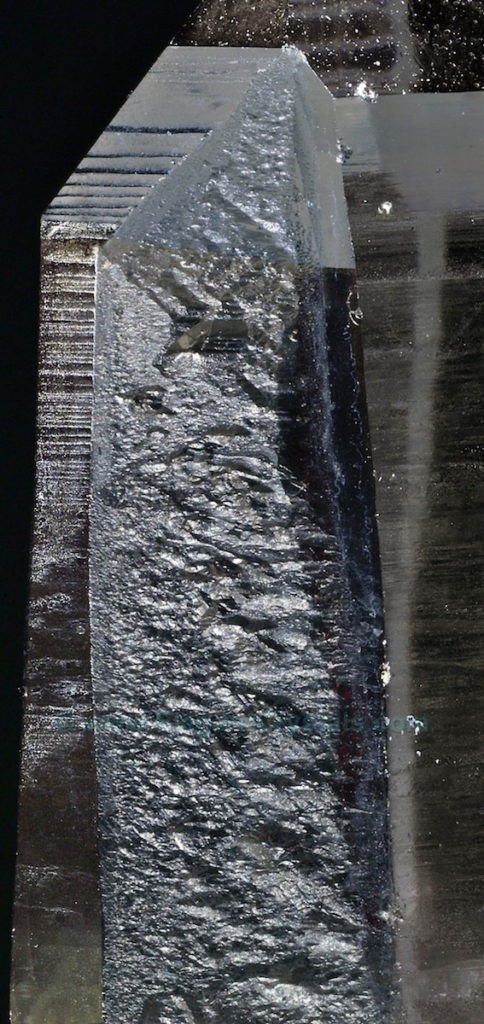
Picture #20
Surface Patterns on Diamintina Quartz
The next four pictures show close-up views of the patterns found on the outside of a Lemurian crystal.
Each of the faces of this all-natural crystal has its own variety of striated patterns or ripples.
In the image above, you are looking at a complicated phenomenon where the central zone consists of an area that originally had another crystal contacting it.
When the second crystal separated from this one, it left a series of patterns that started to grow again as intricate facets.
By lighting this crystal from the side, we can see these “re-healed” patterns in high relief.
On either side of the center facet, you will see typical parallel striations on the original surfaces of the stone.
None of these ripples or striations are water clear, which renders the crystal as slightly frosty under normal lighting.
The black color comes from a dark piece of cloth behind the stone.
This accentuates the surface patterns that reflect white light in the photo studio.
This high-contrast lighting makes the details much easier to see in my photos.
I often use this technique of a dark background to make my crystals “pop” off the page.

Picture #21
Surface Striations in Quartz
With an “Iris Rainbow” Underneath
Like many natural crystals found in Brazil, this Lemurian point has a zone of exquisitely colored rainbows inside.
The colors only cover a 3/4-inch-wide area.
I had to use a powerful magnifying lens to capture their evanescent beauty.
The colors in the crystal are vivid and are reproduced faithfully in this photograph.
You may notice there are parallel lines intersecting the colors.
These are striations on the surface of the clear crystal.
The rainbow lies in a plane about 1/8 inch below the outer facet.
In the darker part of the image at the top, you can see the outer striations showing an iridescent color effect like tiny stars.
One of my favorite activities in this lifetime is chasing ancient rainbows with my camera.
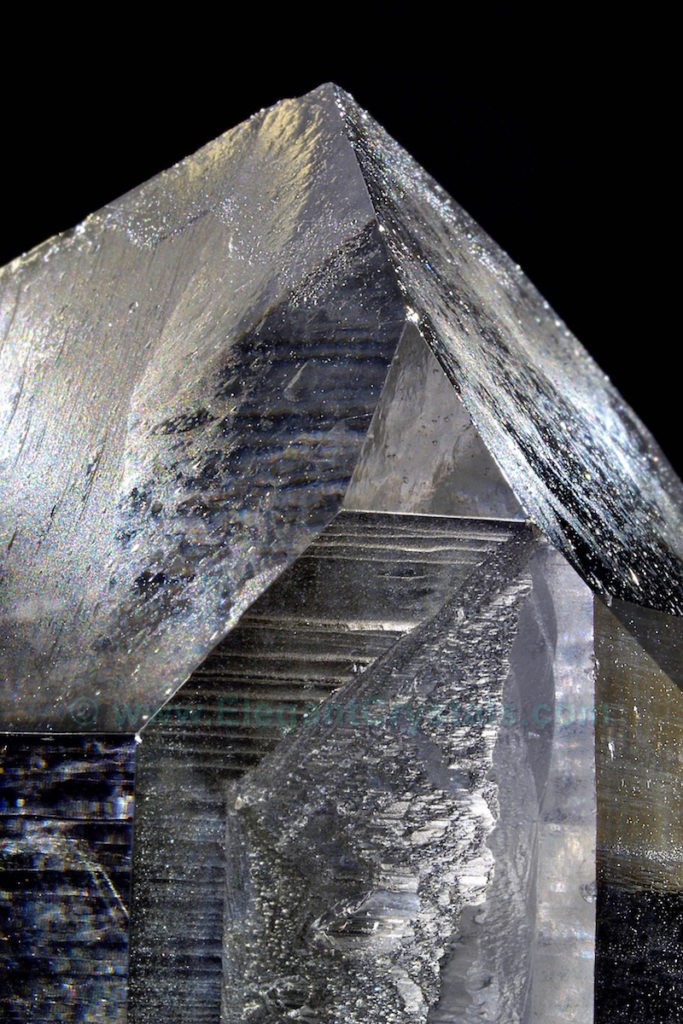
Picture #22
Quartz Crystal Surface Patterns
Here is another view of the Lemurian single point.
Once again, I am using extreme magnification to show how the adjacent facets come together with different striation patterns.
At the very tip of the crystal, you can see two large faces that have been side-lit in a way that defines the texture on the surface of the crystal.
If you have a question about whether your crystal has been polished or not, you can reflect a light off the mirror-like finish to see any tiny shapes that nature may have put there.
Fully polished crystals will appear flat and shiny without any surface details.
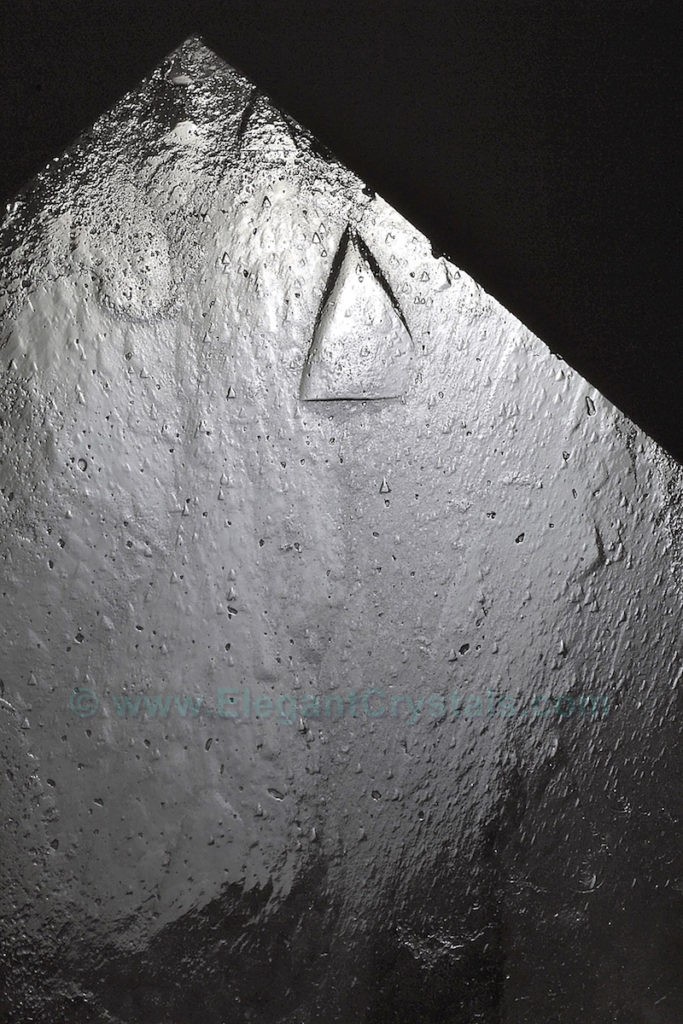
Picture #23
Close-up of Quartz Facets with “Recorder Triangle”
This final image of the Lemurian single crystal shows a highly magnified view of the patterns on one facet at the tip.
This crystal has a so-called “recorder triangle” (“record keeper” or “trigonic facet.”)
It is slightly raised from the flat surface.
If you do not hold the crystal at the exact correct angle to the light, you may never notice these subtle patterns.
Some of the recorder triangles are distinct enough that you can feel them with the tip of your finger.
Occasionally, quartz crystals will have dozens or even hundreds of these triangles, which we will see later in this book.
This stone surface has a slightly melted look, different from the earlier pictures.
My lapidary expert did a light polishing with a super-fine abrasive to shine up a slightly dull surface.
You can see the subtly heated top layer of quartz as being slightly wavy.
Remember, this image is magnified, showing details not normally visible to the unaided eye.
I include this tip to help you better identify your crystal acquisitions.
Sometimes specimens have been cleverly repaired, with various degrees of skill.
Always check the facets at the tip to see if there are crisp-looking striations, record keepers or intricate patterning.
This tells you the crystal is unpolished.
A natural crystal is generally more valuable than a polished one, which affects your ultimate purchase price.
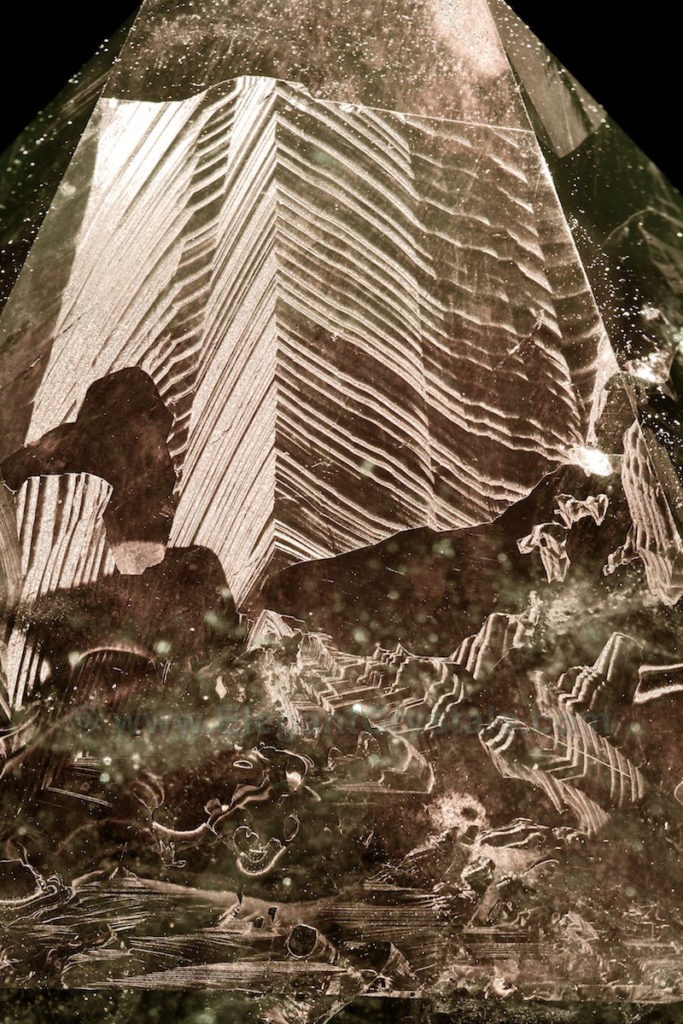
Picture #24
Surface Patterns on Brazilian Smoky Quartz
The way light reflects from a facet tells you whether the facet has been polished.
An ancient natural surface will work like a mirror.
When the sun or a light bulb bounces off the facet, the image of the light source moves in a straight line.
At the edge of the crystal, the reflection of the light suddenly disappears.
On a polished surface, the light’s reflection wavers around in a wiggly fashion.
It looks more like a fun-house mirror than a flat one.
When the bright spot gets to the edge of the facet, it curves over the side in a polished crystal.
Rock cutters with high skill levels may be able to create extremely flat surfaces that do look like perfect mirrors.
That’s great!
The crystal looks awesome.
You can still tell it is polished: there are no patterns at all on the face.
No striations or lines of any sort.
A Record Keeper is identified by triangles on the facets.
Legends say they contain stored information from Atlantis, Lemuria and other ancient civilizations.
Can “record keepers” reveal ancient knowledge and secrets of the universe?
Were crystals consciously and purposely programmed by highly evolved beings?
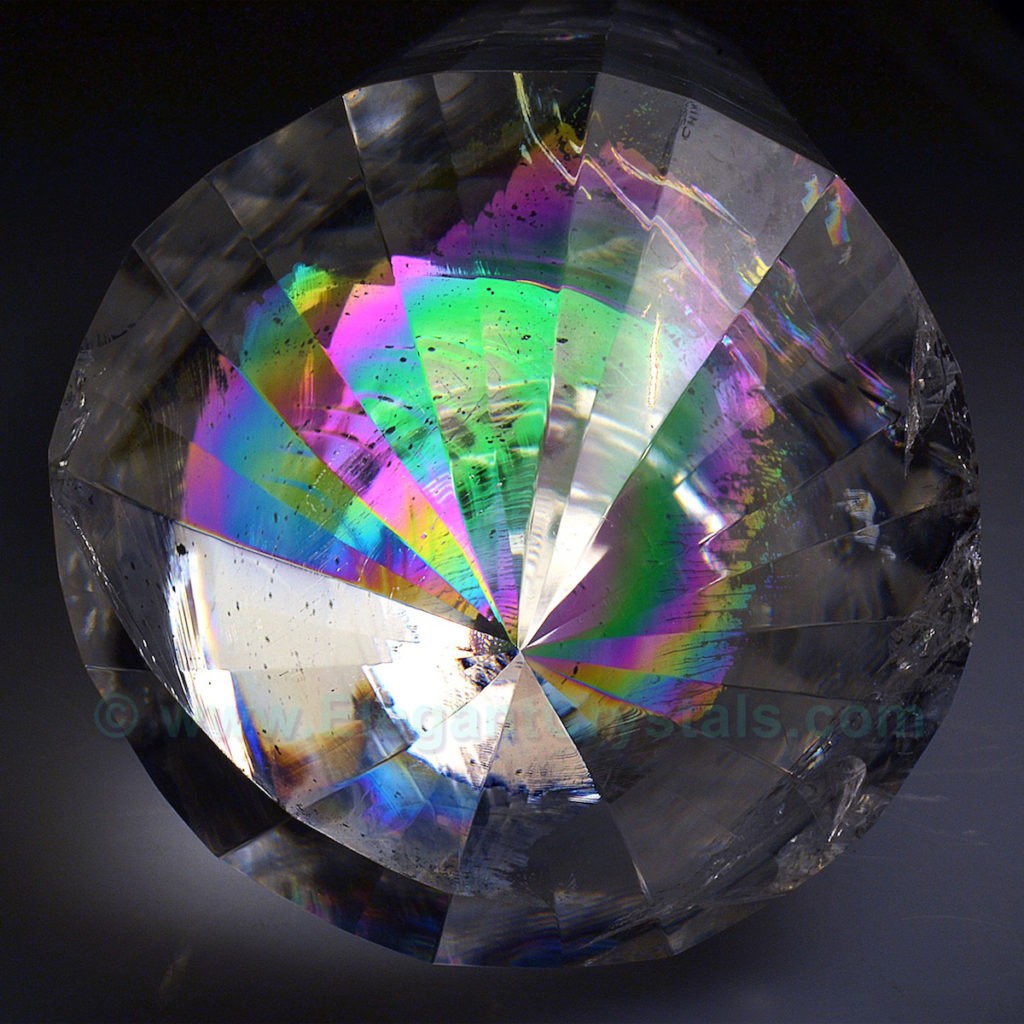
Picture #25
Vogel-cut Quartz Crystal with a Rainbow Recorder in the Tip
Another type of record keeper, called a “rainbow recorder”, shows shimmering colors when you look down into the tip.
It is an ancient kaleidoscope that may holographically store images from lost civilizations.
The first time I heard about a rainbow recorder crystal was from my friend Louis Brill, who saw a demonstration of its record-keeping powers.
The owner of the crystal found a huge curved rainbow under the tip that was visible through all six facets.
For some inspired reason, he beamed a laser light at the crystal while it was sitting on a shelf.
The crystal seemed to reflect images of ancient civilizations onto the wall.
In effect, the iris rainbow in the crystal became a holographic projector.
Was it programmed with pictures from Atlantis?
I guess that’s a matter of opinion.
Amazingly enough, these pictures of an ancient civilization came alive when the crystal was rotated.
They turned into moving images: movies from the distant past.
Louis was amazed at the display.
He could hardly wait to tell me about his special experience.
I think any crystal can open you to information from the Universal Computer System, called the Akashic Records in Sanskrit legends.
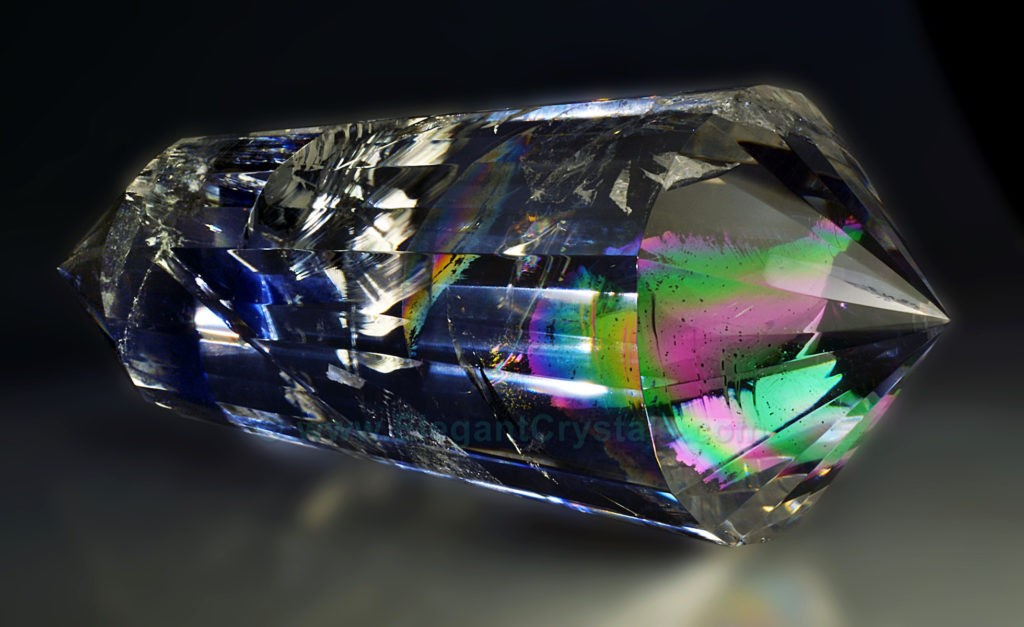
Picture #26
Second View of the Six-inch-long Vogel-cut Rainbow Recorder
This symmetrical double-ended shape was designed by Dr. Marcel Vogel, a crystallographic scientist at IBM Laboratories.
His research yielded especially energetic quartz crystal shapes for hand’s-on healing energy work.

Picture #27
12-inch-tall Brazilian Quartz Crystal, Partly Polished
Here is another Lemurian crystal from Diamantina, Brazil.
This one is over 12 inches long.
I include it in this book because it displays a quality unusual to the many crystals that I have looked at so far.
This one is special because it has a partly polished facet.
It was interesting to see a blend of natural striations with adjoining glossy polished areas.
The following pictures show you the differences in the reflections from polished faces and naturally striated facets.
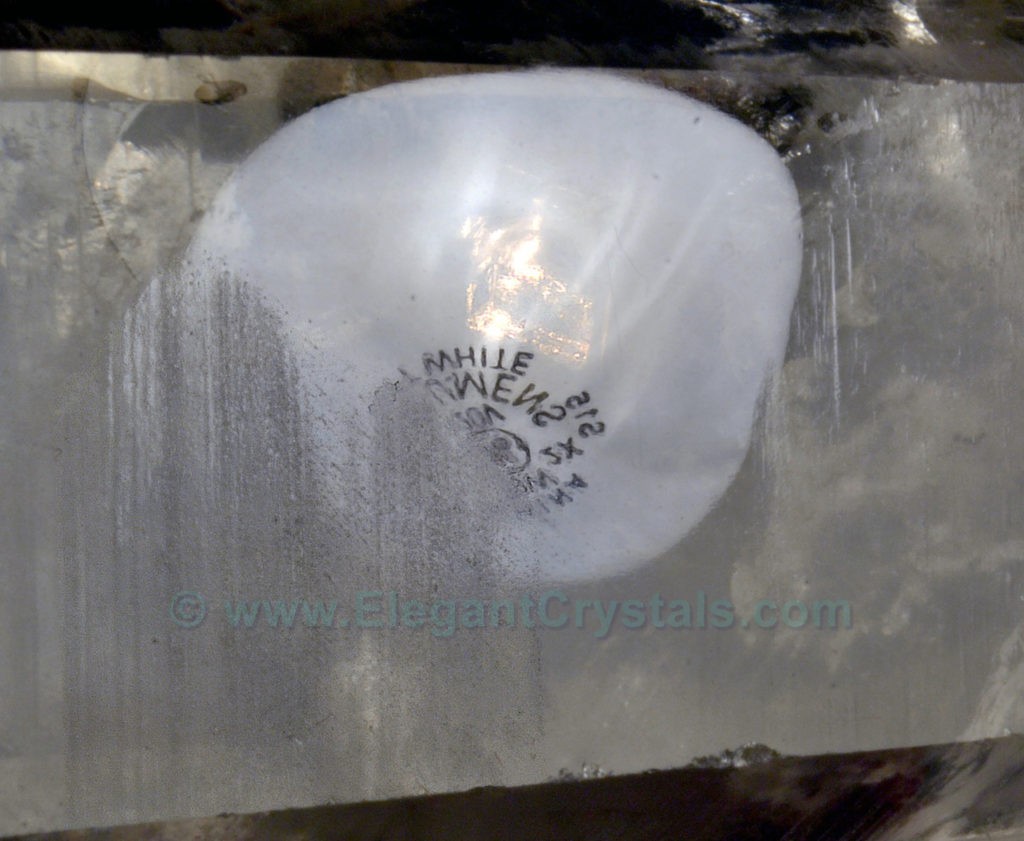
Picture #28
Mirror Images in Polished Quartz
This is an image like nothing I have seen before.
The crystal has a highly polished zone that acts like a rather good mirror.
You can see the backwards reflection of a light bulb in some detail.
Towards the left side of the picture, there is a zone of natural striations that blurs out the reflections from the light bulb.
While this may not initially grab your attention, the cutter accomplished an interesting effect by contrasting the original surface of the stone with his mirror-like finish.
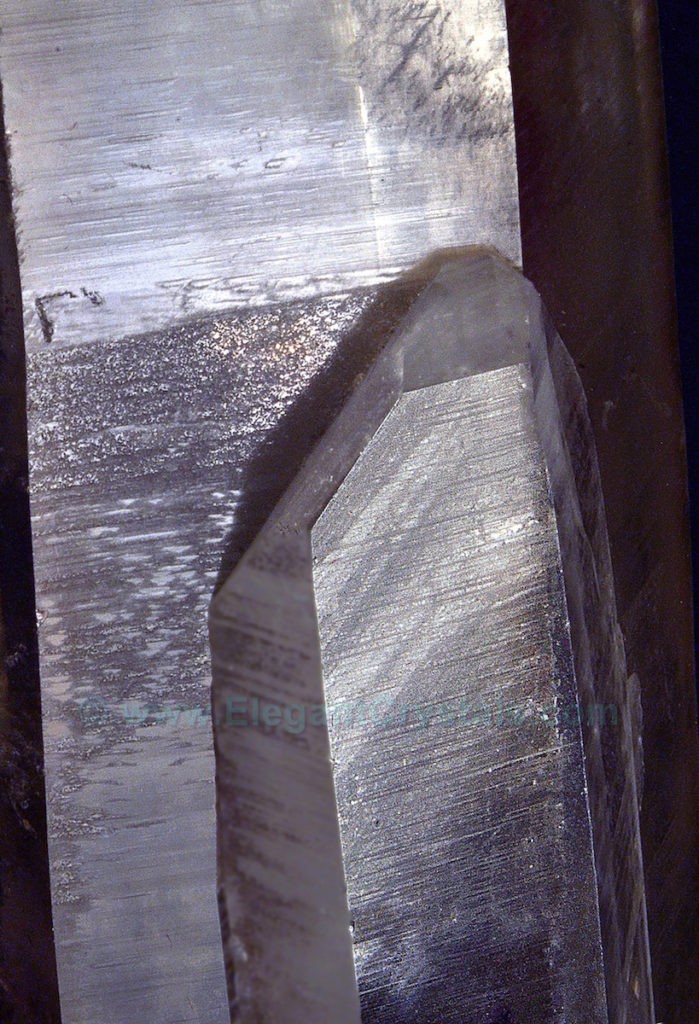
Picture #29
Cross-wise Striations in Brazilian Quartz
Part of this same crystal shows slightly frosty striated patterns on the original surfaces.
On the right side of this image you can see one set of parallel lines on the surface of the crystal with a diagonal set of striations on the back of the clear crystal interface.
In effect, the molecular patterns are running in two different directions that are visible at the same time due to the clarity of the stone.
Even when there is a lot of clarity inside the crystal, heavy striations can sometimes make it difficult to see details of the interior.
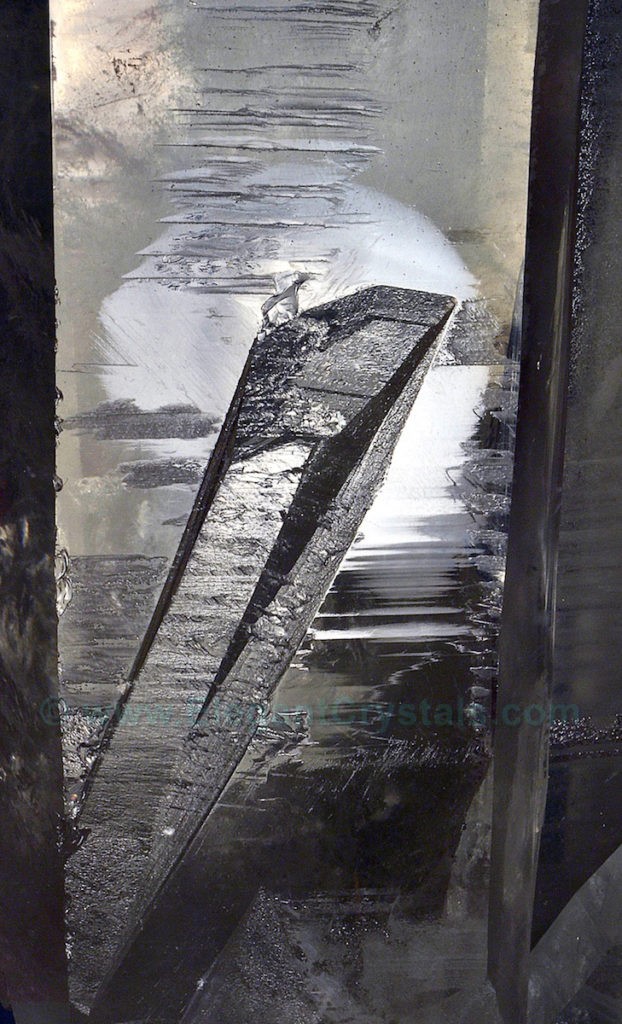
Picture #30
Indentations in Quartz Crystal Surfaces
Once again, we look at the same stone.
It exhibits wide varieties of clarity, glossiness and texture.
In the middle of this image, you can see where a thin crystal fell off from the larger stone.
This is called an interface pattern.
Surrounding it, the light bulb is diffused by the all-natural patterns on the quartz surface.
While much of the surface looks glossy, the image of the bulb is distorted by microscopic imperfections.
These small rippled patterns are tip-offs that this facet has not been polished.
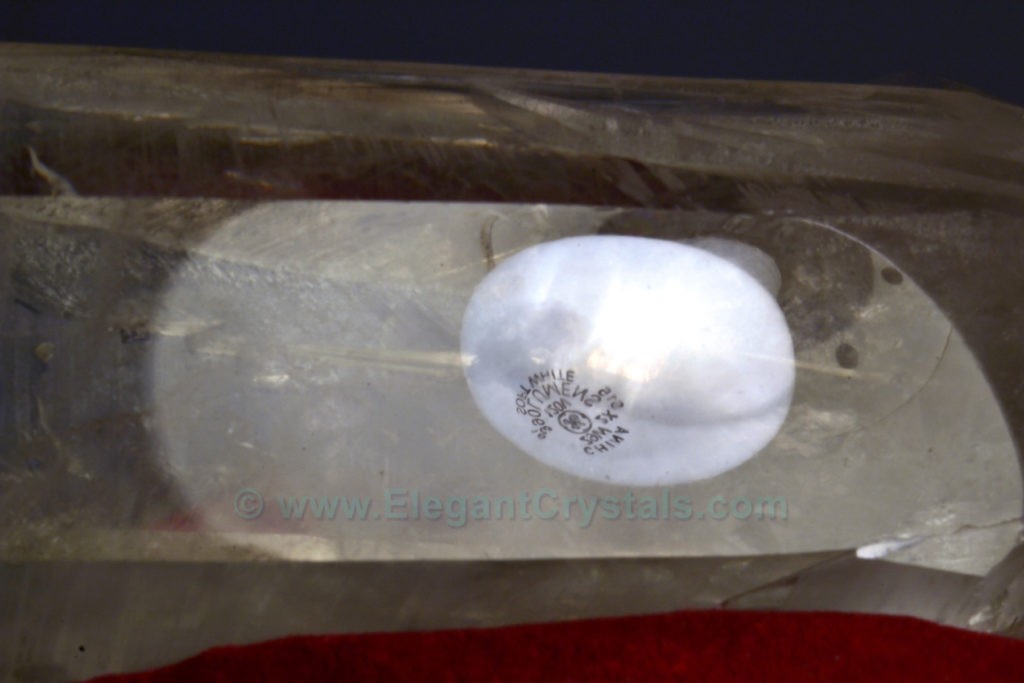
Picture #31
Mirror Finish on a Polished Quartz Crystal
Finally, our Lemurian crystal friend shows us the perfection of a highly polished flat surface.
I have positioned the light bulb inside a white reflector so that it bounces off the facet like a mirror.
The reflected image is almost perfect.
There are no textures on the polished surface to indicate that the crystal was left in its natural state.

Wow so much interesting information, quartz is definitely my favourite crystal , great E-Book